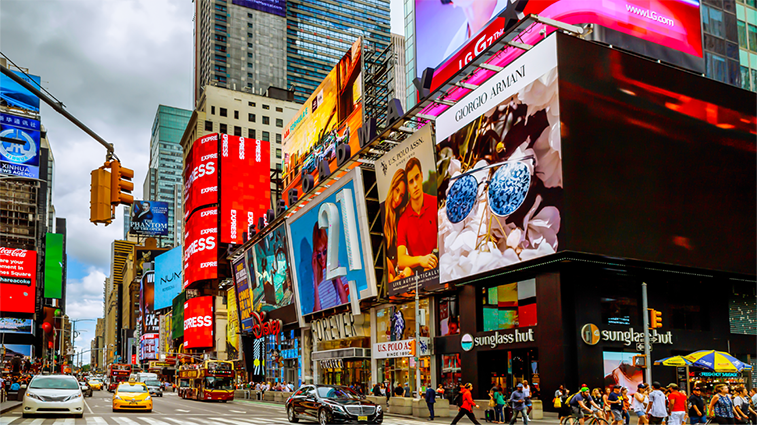
Where Do I Sign?
Though New Yorkers may feel inundated with signage, signage is heavily regulated by the Zoning Resolution’s Use Regulations in Article 3 Section 2. The Zoning Resolution heavily regulates signage in residential districts, while commercial and manufacturing districts are generally more permissive.
The Zoning Resolution defines a sign as any writing (including letter, word or numeral), pictorial representation (including illustration or decoration), emblem (including device, symbol or trademark), flag (not including the US flag) or any other figure of similar character, that:
- Is a structure or any part thereof, or is attached to, painted on or in any other manner represented on a building or other structure;
- Is used to announce, direct attention to, or advertise; and
- Is visible from outside a building. A sign shall include writing, representation or other figures of similar character, within a building, only when illuminated and located in a window.
The Zoning Resolution makes a distinction between advertising and business signs (also called accessory signs). An advertising sign is defined as “a sign that directs attention to a business, profession, commodity, service or entertainment conducted, sold, or offered elsewhere than upon the same zoning lot and is not accessory to a use located on the zoning lot.” Business signs are signs that are located on the same zoning lot of the business.
Types of signs
The Zoning Resolution’s classifies signs by their degree of illumination. The four main illumination classifications for signs are non-illuminated, illuminated, illuminated flashing and indirectly illuminated.
Non-illuminated signs are signs that emit no artificial light directly or indirectly. Of the four sign classifications, the Zoning Resolution views a non-illuminating sign as the least obtrusive. They are generally allowed in all districts so long as size, height and placement provisions are met.
The Zoning Resolution defines illuminated signs as a “sign designed to give forth any artificial light or reflect such light from an artificial source.”
A sign with indirect illumination is a “non- flashing sign whose illumination is derived entirely from an external artificial source and is so arranged that no direct rays of light are projected from such artificial source into residences or streets.”
A flashing sign is “any illuminated sign, whether stationary, revolving or rotating, that exhibits changing light or color effects.” The Zoning Resolution treats flashing signs with the highest scrutiny, allowing them in the fewest number of districts. In addition to illumination classification, each sign will be either an advertising or business sign.
Residential Districts
New York City’s residential districts have the most stringent sign requirements. Advertising and illuminated signs (including indirectly illuminated and flashing) are not permitted in residential districts. Residential districts do allow a variety of non-illuminated signs. The Zoning Resolution allows accessory signs, nameplates, identification signs, for sale/rent and parking signs in residential districts provided that size, height and placement provisions are met. The Zoning Resolution makes additional allowances for community facilities and hospitals located in residential districts.
Commercial Districts
Commercial districts have the most permissible allowances for signage, and therefore the most advertising and illuminated signs. The Zoning Resolution’s main distinction for signage allowance in a commercial district is whether the sign is advertising or business.
All business signs are permitted in all commercial districts (C1-C8) as long as illumination, size, height and placement provisions are met. However, advertising signs are only allowed in districts C6-5, C6-7, C7 and C8. District C8 only allows advertising signs that are non-illuminated. The higher commercial district numbers (C4-C8) allow bigger signs with more square footage.
Signs of all illumination types are allowed, subject to size, height and placement requirements, in all commercial districts except districts C1, C2 and C6-1A which do not allow any flashing signs. Permitted districts may not allow these signs to be advertising signs.
There are additional provisions for signage on awning and roofs, adult establishments, near parks, waterways, on adult establishment and on residential or mixed buildings within a commercial district.
Districts labeled Special Purpose Districts may have individual allowances or restrictions for signage. Times Square, Greenwich Village and Union Square are Special Districts with unique signage rules.
Manufacturing Districts
The Zoning Resolution allows more signage in manufacturing districts than residential districts. Some advertising signs and illuminated signs are allowed.
Illuminated and flashing signs are only permitted in manufacturing districts if they are not advertising and meet size, height and placement provisions. The only advertising signs allowed in manufacturing districts are non-illuminating signs and signs with indirect illumination.
Many manufacturing districts in New York are a hybrid of manufacturing and residential. Though illuminated, non-advertising signs are allowed, they cannot project or reflect onto residences or live-work spaces. All signs have size restrictions. Generally, a size restriction is an allowed surface area in square feet, or an allowed size that is proportionally greater than the size of the zoning lot.
The Department of Buildings issues hefty fines for sign violations. First time offenses are $10,000 and subsequent violations are $25,000. It’s critical for building owners and property managers to understand sign regulations or consult a code specialist before installing signs, as sign vendors do not assume responsibility for sign violations.
Have a signage question? Need consultation or expediting? Contact us.








